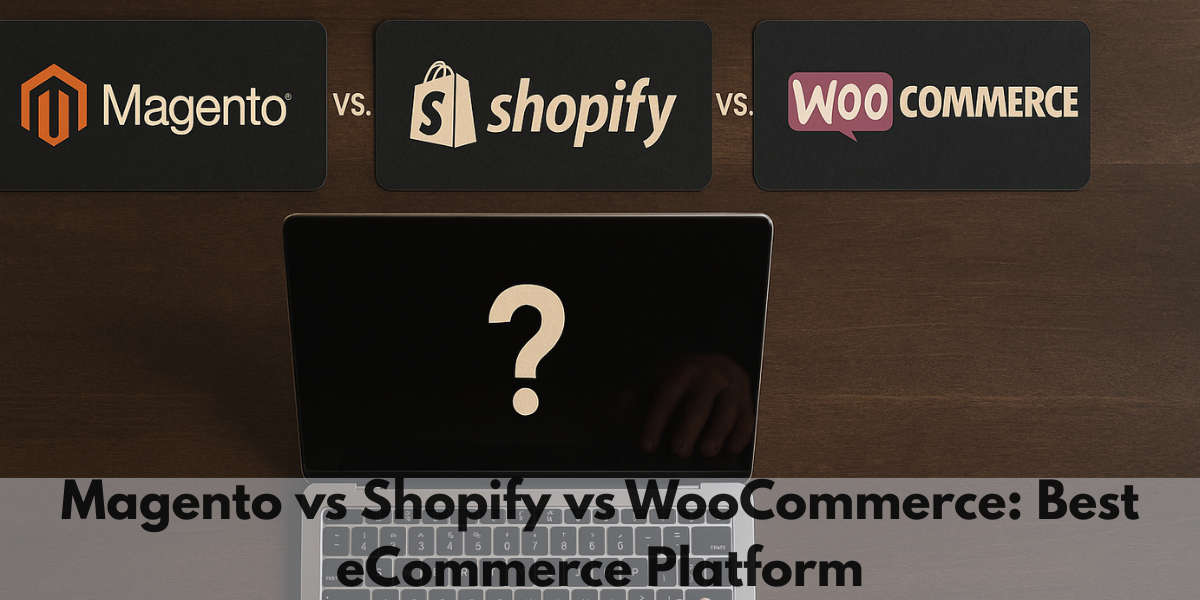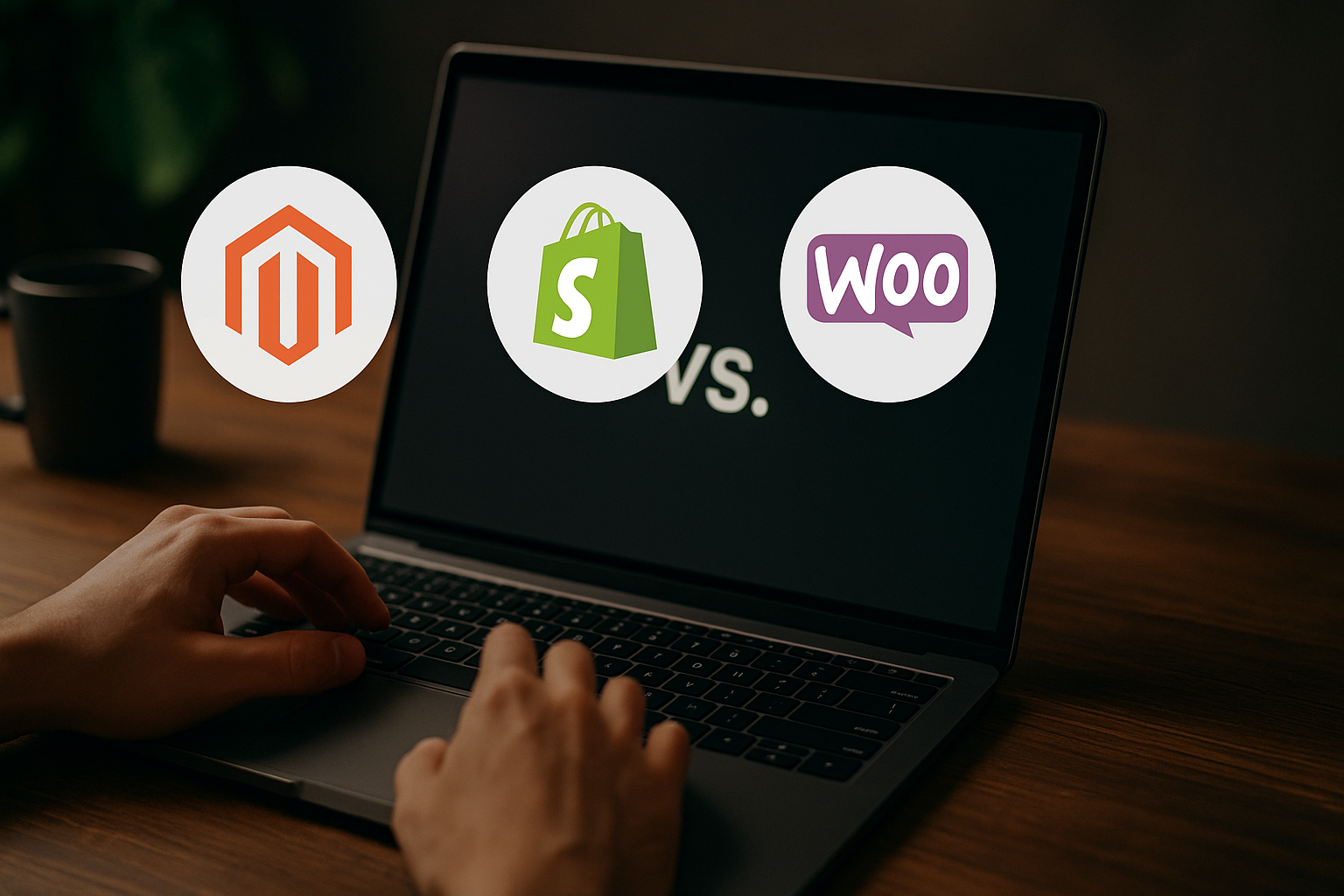
Choosing between Magento, Shopify, and WooCommerce hinges on your business needs. Shopify offers the simplest, all-in-one hosted solution (ease of use, security, maintenance handled). WooCommerce (a free WordPress plugin) provides maximum flexibility and control at lower upfront costs, ideal for WordPress users. Magento (open-source or Adobe Commerce) delivers unparalleled power and customization for large, complex enterprises but demands significant technical resources. There's no single "best" platform—evaluate based on your budget, technical expertise, scalability needs, and desired level of control.
The thought of having an e-commerce website design service may not appeal to all of us. However, after getting the right information for your software, you would be more than happy to qualify it as your online ecommerce store development system. With the help of an ecommerce shopping cart system, you would enable businesses to set up stores on the Internet. With this method, businesses can showcase and promote their product reach to a global audience. It can also provide customers with a highly secure shopping experience on the Internet. Website development is quite easy and cheap, and this would allow small businesses to create a store on the internet.
I’m wondering what would be the most reliable ecommerce solution for the creation of a web store? Well, you’ve got leading eCommerce platforms for your work; Magento vs. Shopify vs. WooCommerce solutions.
Table of Contents
An Overview of Magento
Having launched in 2008 as an open-source platform on the web, Magento has developed as one of the most renowned content management systems. Magento has a 34 percent ecommerce website market share. With Magento, you would find everything complicated to start with. However, once it begins functioning at its highest speed, it will provide the most versatile and intuitive shopping experience to the customers. Magento is lively and diversely rich in features, by which we can get the answer, Why choose Magento? But this doesn’t end the debate about Magento vs. Shopify vs. WooCommerce here. Magento for ecommerce successfully fulfills all the cart requirements of an ecommerce website.
Simple integration
Magneto allows you to easily integrate your online website with the required edge to create a dynamic interface that not only allows you to compel and sell but also provides your website visitors with a great shopping experience.
Versatile processes
Keeping the limited bandwidth aside, the simple and huge versatility of the Magento interface would make it a great choice for small businesses on the internet. With the help of a simple Magento tutorial, you can develop a store within an hour’s duration.
What is Shopify?
Without technical expertise, entrepreneurs and businesses can create, develop, and run online stores. As, Shopify offers a hosted, SaaS-based (Software-as-a-Service) eCommerce platform. Shopify, which runs over 2 million retailers globally, is renowned for its ease of use, adaptability, and scalability.
It offers a drag-and-drop website builder, pre-made templates, and multi-channel selling capabilities. And enables you to sell on your website, in-store via POS, or on social media sites. Shopify looks at maintenance, security, and hosting so you can focus on expanding your brand. Shopify website development is used by several well-known firms, including Netflix, Heinz, Red Bull, and Kylie Cosmetics.
And what does WooCommerce offer?
Now we come last in the debate of Magento vs. Shopify vs. WooCommerce. WooCommerce is a choice if your company is with the WordPress ecosystem. WooCommerce integrates easily with WordPress and turns your website into a fully functional online store. It’s quite intuitive for WordPress users because it’s designed as a plugin. And it seems like a natural extension than a stand-alone platform. WooCommerce can accommodate your demands, whether for basic digital product stores. With thousands of plugins to choose from, it’s a flexible powerhouse for companies to expand their online store.
Magento vs. Shopify vs. WooCommerce: A Comparison to Guide

⚡️ Quick Comparison Table
| Feature | Magento | Shopify | WooCommerce |
|---|---|---|---|
| Best For | Large enterprises | SMBs, beginners | WordPress users |
| Pricing | Free (Open Source) + high hosting/dev costs | $39-$399/month + transaction fees | Free plugin + hosting/themes costs |
| Ease of Use | Complex (needs developers) | Drag-and-drop simplicity | Moderate (WordPress knowledge) |
| SEO | Advanced control | Good basics | Excellent (WordPress SEO) |
| Scalability | Enterprise-grade | Up to Shopify Plus | Depends on hosting |
| Security | Self-managed | Fully managed | Self-managed |
Pricing
Cost is always the primary idea when selecting an ecommerce platform. Shopify offers a monthly membership-based tier pricing level, with a cost of $39. In Shopify vs. WooCommerce, the latter is an open-source, free plugin that works with WordPress. Although there is no monthly membership fee, SSL certificates, premium themes, domain names and hosting services can generate expenses. Because WooCommerce is a scalable and adaptable solution ideal for companies seeking full control. With its free and open-source community version, Magento development services takes a similar approach to WooCommerce. So, the question is WooCommerce better than Shopify? However, Adobe Commerce has a high licensing cost for large businesses. The requirements for hosting, development, and maintenance lead to a rapid increase.
Ease of Use
Unless you are using Magento without a tech team, installing an online business isn’t launching a spaceship. Of Magento vs. Shopify vs. WooCommerce, Shopify is the most user-friendly for beginners. Shopify eliminates any technical obstacles with its user-friendly administrator panels and ready-to-use templates. For those entrepreneurs who want to start immediately without writing a line of code, this is perfect.
WooCommerce is ideally located in the center. If you are already familiar with WordPress, it is a valuable tool. As it increases its content management devices and integrates. There is a learning state, however, if you have never worked with web programming before. In contrast, Magento is designed for developers.
Design
With the first click, the visual appeal affects the client’s trust and engagement. Shopify offers contemporary, liable subjects, many of which are well-made and independent. It is quite simple to adapt, especially if you follow the guidelines of the stage. You can choose from thousands of WordPress themes with WooCommerce for the eCommerce Store. If you already use it, you can probably change your favorite WordPress theme for WooCommerce. But the design is Magento. Developers can create a unique shopping experience if they have full access to layout files and source code. For those brands that want to stand out with a unique look and feel, this is perfect.
SEO
The long-term visibility discovery of your store depends on engine optimization. It does not matter how grand your design is if customers cannot find you on Google. Or which out of Magento vs. Shopify vs. WooCommerce do you use? Shopify comes with an SEO tool consisting of a sitemap, meta details, and configurable title tags. Most users find it sufficient, but there is a lack of flexibility for more complex adjustments. All the famous SEO benefits of WordPress are transferred to WooCommerce. It is ideal for material-rich shops because it gives you fine control over everything from Schema Markup to Canonical URLs like SEO. Magento was designed to understand the wider SEO performance. It offers an enterprise-grade toolkit that includes complex SEO rules, custom URLs, and Redirects. However, with other Magento capabilities, you will need a developer to customize SEO.
| Feature | Magento | Shopify | WooCommerce |
|---|---|---|---|
| URL Control | ✅ Full | ⚠️ Limited | ✅ Full |
| Schema Markup | ✅ Advanced | ⚠️ Basic | ✅ Advanced |
| Page Speed | ⚠️ Needs optimization | ✅ Fast | ⚠️ Host-dependent |
| Plugins | Yoast, SEO Suite | Built-in tools | Yoast, Rank Math |
Customization
Your platform should suit the specific needs of each organization. Shopify offers optimization with different third-party apps and its liquid templating language. Nevertheless, deep changes are limited until you are familiar with working within the Shopify ecosystem. The open-source nature of WooCommerce gives it tremendous flexibility. From checkout procedures to backend functionality, developers can change every aspect of the store. Additionally, you can add almost any feature without starting from scratch. When it comes to adaptation, Magento is best without a doubt. The platform’s modular architecture enables developers to create unique experiences. However, you will need more technical assistance for personalization.
Performance
Customer experience and your SEO results are affected by page speed, uptime, and accountability. Or which platform Magento vs. Shopify vs. WooCommerce you use for an eCommerce store. Because Shopify is a fully hosted platform, it excels in this position. It provides quick, reliable store exit outside the box by handling server management, adaptation, and performance monitoring. Your hosting provider has a significant impact on the performance of WooCommerce. With high-quality hosting, WooCommerce can work at its speed. However, less expensive hosting when traffic is high often results in slow load time and outages. Magento requires a lot of resources. You will need strong hosting and careful site optimization to get the best speed and uptime. It requires commitment, but if done well, it can be brilliantly on the scale.
Scalability
Your platform should be able to manage 100 orders or 10,000 processing. Shopify is favorable for small to medium-sized enterprises that desire to grow continuously. As your business grows, you can upgrade your plans and switch to Shopify plus in Shopify vs. WooCommerce vs. Magento. When combined with reliable hosting and development, WooCommerce can be effective on a scale. To expand companies that want to control their infrastructure, this is ideal. Scalability is a feature of Magento. It can meet the demands of MNCs in multi-story setups, internationalization, and complex inventory management. However, important technical resources are required on this scale. Safety is necessary when it comes to ecommerce. You can lose money, reputation, and even legal issues because of a violation.
Security
Security is crucial when choosing between Magento vs. Shopify vs. WooCommerce for your store. Safety is included in the bundle of Shopify. Shopify SSL Certificates and PCI handle compliance and frequent upgrades. You do not need to put in any more work. WooCommerce depends on you to keep it safe. Updates, backup, SSL, and vulnerability monitoring should be controlled by you. Or you can choose a managed WordPress host that does these tasks for you. You have complete control over safety with Magento but may have shortcomings. Advanced rescue can be applied, but they require ongoing care and attention.
Support and Community
And finally, how good do you get when things go wrong? Shopify provides extensive customer service through forums, emails, and chats. They provide a comprehensive support center. WooCommerce depends on community forums, documentation, and other sources rather than providing direct support. Developers of premium extensions usually provide direct support. As long as they are not paying for Adobe Commerce, Magento users mostly rely on community forums. Many Magento users hire special support teams due to their complexity.
Conclusion: The selection of the “best” platforms between Magento vs. Shopify vs. WooCommerce is not the goal. Rather, it is about determining which best meets the needs of your company. Magento gives unmatched power to businesses and offers WooCommerce control and flexibility. While Shopify provides simplicity and dependence. The best platform will emerge when you assess your objectives, technical proficiency, and financial obstacles.
FAQs
Q1. What distinguishes WooCommerce vs. Magento vs. Shopify?
Shopify offers a selection of free, expertly created themes that are simple to modify to fit your brand. WooCommerce’s extensive collection of WordPress themes offers a wide range of design possibilities as well. In the meantime, Magento provides the greatest degree of design freedom, meeting the needs of companies with distinct branding requirements.
Q2. Which is superior, Shopify or Magento?
With a set price and a simple drag-and-drop interface, Shopify is a hosted platform that is more suited for beginners. In addition, Magento offers a plethora of free integrations and greater flexibility and customization choices. You’re in the perfect location if you’ve been having trouble deciding between Magento and Shopify.
Q3. Which platform works best for big businesses?
Magento (Adobe Commerce) is the best option if your company requires sophisticated custom features, multi-store support, and high scalability. Although it needs technical resources, it is powerful. Shopify Plus is a strong rival for businesses seeking easier administration.
Q4. Can I integrate third-party tools and apps easily?
Yes, but there’s a difference:
- Shopify: 8,000+ apps in the plug-and-play marketplace.
- WooCommerce: Thousands of WordPress plugins.
- Magento: Highly extendable but often needs dev support to integrate.
Q5. Is it possible to move from Shopify to WooCommerce?
Moving your Shopify store to WooCommerce is simple. You can import items, orders, coupons, blogs, and pages from Shopify to WooCommerce with ease thanks to the Migrate Shopify to WooCommerce plugin. To reduce the possibility of data loss, it allows you to move all the data at once.


